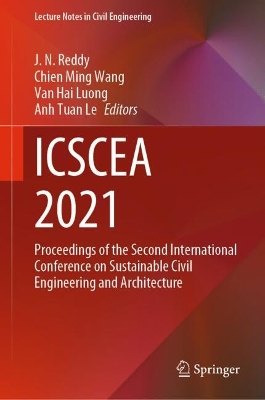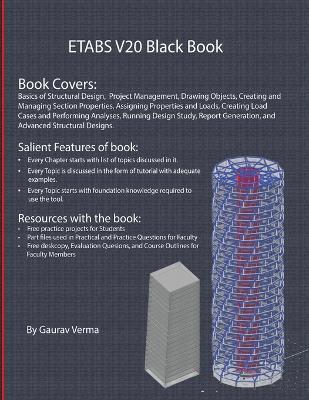Build Like It's the End of the World
 portes grátis
portes grátis
Build Like It's the End of the World
A Practical Guide to Decarbonize Architecture, Engineering, and Construction
Chopson, Patrick; Ahuja, Sandeep
John Wiley & Sons Inc
09/2024
400
Dura
Inglês
9781394179176
Pré-lançamento - envio 15 a 20 dias após a sua edição
Descrição não disponível.
Foreword xvi
Acknowledgments xvii
1 A Call to Action - Climate Change and the Role of the Built Environment 1
1.1 How Big Is the Problem of Climate Change? 1
1.2 What is the Business Opportunity for the AEC Industry? 30
1.3 A Roadmap for Contractors 46
1.4 Conclusion 49
2 What is Carbon Positive Design? 51
2.1 Introduction 51
2.2 Step 1: Set Decarbonization and Project Goals 52
2.3 Step 2: Evaluate Design and Construction Processes 65
2.4 Step 3: Develop Targeted Solutions 69
2.5 Step 4: Create an Implementation Plan 83
2.6 Step 5: Validating and Verifying the Finished Design 87
2.7 Conclusion 97
2.8 Case Study: Georgia Tech Campus Center 98
3 What is Carbon Positive Construction? 107
3.1 Considering Variables Beyond Cost 107
3.2 Reshaping Regulation and Raising Transparency 109
3.3 Rewiring the Contractual Framework 112
3.4 Redefining Design and Engineering Approaches 118
3.5 Improving Procurement and Supply-Chain Management 125
3.6 Improving On-Site Execution 130
3.7 Infusing Digital Technology, New Materials, and Advanced Automation 135
3.8 Reskill the Workforce 141
3.9 Conclusion 144
3.10 Insights from Natalie Terrill, Director of Sustainability at Beck Group 145
4 The Business Case for Carbon Positive Buildings 151
4.1 The Interconnection Between Climate Risk, Finance, Insurance, and Economic GDP 151
4.2 The Role of Climate Risk in Finance, Insurance, and Economic GDP 154
4.3 The Role of Policy and Regulation in Encouraging Low-Carbon Building Investments 164
4.4 The Opportunities for the Finance Sector in Supporting Low-Carbon Building Investments 172
4.5 The Competitive Advantage of Decarbonized Buildings 175
4.6 The Business Case for Low-Carbon Buildings 180
4.7 Opportunities for Energy Savings and Revenue Generation 188
4.8 Case Study - Emory University Campus Life Center 190
4.9 Insights from Michael Beckerman, CEO at CREtech 195
4.10 Insights from VC Shaun Abrahamson, Managing Partner at Third Sphere 198
5 The Role of Data-Driven Design in the Implementation Process 201
5.1 Current Challenges in the Building Design Process 203
5.2 Digital Technologies in Decarbonization Strategies 204
5.3 The Impact of Rapid Digitalization in Construction 209
5.4 The Influence of Modular Construction Techniques 213
5.5 Insights from Dennis Shelden, Associate Professor at Rensselaer Polytechnic Institute 215
5.6 The Potential of Emerging Technologies 217
5.7 Building Information Network (BIN): A New Paradigm 220
5.8 Applying the GitHub Model to Building Design 223
5.9 Decarbonization Strategies in the BIN Framework 226
5.10 Case Study: How a Change in Wall Structure can Impact the Entire Building Design 228
5.11 Case Study: How a Simple Change (Like Changing a Door) can be Efficiently Managed in a BIN Framework 229
5.12 The Challenges Amid Rapid Industry Change and Industrialization 231
5.13 Change Management in the Digital Era 233
5.14 Conclusion 236
5.15 Insights from Tristram Carfrae RDI, Deputy Chair at Arup 237
6 Decarbonizing Buildings: "The Low Hanging Fruit" 241
6.1 Understanding the Basics of Building Science 241
6.2 Site Selection and Building Orientation 248
6.3 Passive Design Strategies: Harnessing the Power of Nature 253
6.4 Case Study: High Performance Tower by TVS Architecture and Interior Design 265
6.5 Harnessing the Microclimate 270
6.6 Refining Solar Heat Utilization: Thermal Mass and Window Placement for Climate-Responsive Design 273
6.7 Internal Gains and Their Role in Building Performance 276
6.8 Daylighting and Lighting Power Density: Crucial Factors in Energy Efficiency 278
6.9 Case Study: The Importance of Reducing Lighting Power Density 278
6.10 Conclusion: Empowering Change Through Accessible Measures 279
6.11 Dr. Pablo La Roche | Principal and Professor | CallisonRTKL, Arcadis | Cal Poly Pomona 279
7 Shifting Decision Making Early into the Process 287
7.1 The Architectural View and Decision-Making 288
7.2 The Importance of Early Understanding and Exploration 292
7.3 Case Study: Phase 2 of Health Sciences Research Building 301
7.4 Chirag Mistry AIA, LEED AP | Senior Principal, Regional Leader of Science + Technology | HOK | Atlanta, GA 311
7.5 Consequences of Process Deficiencies 313
7.6 Leveraging Technology for Early Decision-Making 314
7.7 Policies, Regulations, and Early Decision-Making 318
7.8 Insights from Sarah Gudeman, Principal and Building Science Practice Lead at Branch Pattern 326
7.9 Conclusion 328
8 Ensuring Carbon Positive Decisions Make it to Final Construction Documents 331
8.1 The Continuous Effort in Meeting Performance Objectives 332
8.2 Assuring Appropriate Programming and Establishing Design Objectives 337
8.3 Kate Simonen, AIA, SE | Professor | University of Washington 342
8.4 Leveraging Lessons Learned and Instituting Quality Assurance 346
8.5 Eric Borchers | Structural Engineer | KAI Hawaii, Inc. | Honolulu, HI 350
9 The Consequences of Inaction 353
9.1 What Real Commitment Looks Like 354
9.2 Catalyzing Change: Strategies for Decarbonization 355
9.3 Our Last Chance 357
Epilogue: Crafting Our Future Landscape 361
Appendix A 363
Sources 365
Index 369
Acknowledgments xvii
1 A Call to Action - Climate Change and the Role of the Built Environment 1
1.1 How Big Is the Problem of Climate Change? 1
1.2 What is the Business Opportunity for the AEC Industry? 30
1.3 A Roadmap for Contractors 46
1.4 Conclusion 49
2 What is Carbon Positive Design? 51
2.1 Introduction 51
2.2 Step 1: Set Decarbonization and Project Goals 52
2.3 Step 2: Evaluate Design and Construction Processes 65
2.4 Step 3: Develop Targeted Solutions 69
2.5 Step 4: Create an Implementation Plan 83
2.6 Step 5: Validating and Verifying the Finished Design 87
2.7 Conclusion 97
2.8 Case Study: Georgia Tech Campus Center 98
3 What is Carbon Positive Construction? 107
3.1 Considering Variables Beyond Cost 107
3.2 Reshaping Regulation and Raising Transparency 109
3.3 Rewiring the Contractual Framework 112
3.4 Redefining Design and Engineering Approaches 118
3.5 Improving Procurement and Supply-Chain Management 125
3.6 Improving On-Site Execution 130
3.7 Infusing Digital Technology, New Materials, and Advanced Automation 135
3.8 Reskill the Workforce 141
3.9 Conclusion 144
3.10 Insights from Natalie Terrill, Director of Sustainability at Beck Group 145
4 The Business Case for Carbon Positive Buildings 151
4.1 The Interconnection Between Climate Risk, Finance, Insurance, and Economic GDP 151
4.2 The Role of Climate Risk in Finance, Insurance, and Economic GDP 154
4.3 The Role of Policy and Regulation in Encouraging Low-Carbon Building Investments 164
4.4 The Opportunities for the Finance Sector in Supporting Low-Carbon Building Investments 172
4.5 The Competitive Advantage of Decarbonized Buildings 175
4.6 The Business Case for Low-Carbon Buildings 180
4.7 Opportunities for Energy Savings and Revenue Generation 188
4.8 Case Study - Emory University Campus Life Center 190
4.9 Insights from Michael Beckerman, CEO at CREtech 195
4.10 Insights from VC Shaun Abrahamson, Managing Partner at Third Sphere 198
5 The Role of Data-Driven Design in the Implementation Process 201
5.1 Current Challenges in the Building Design Process 203
5.2 Digital Technologies in Decarbonization Strategies 204
5.3 The Impact of Rapid Digitalization in Construction 209
5.4 The Influence of Modular Construction Techniques 213
5.5 Insights from Dennis Shelden, Associate Professor at Rensselaer Polytechnic Institute 215
5.6 The Potential of Emerging Technologies 217
5.7 Building Information Network (BIN): A New Paradigm 220
5.8 Applying the GitHub Model to Building Design 223
5.9 Decarbonization Strategies in the BIN Framework 226
5.10 Case Study: How a Change in Wall Structure can Impact the Entire Building Design 228
5.11 Case Study: How a Simple Change (Like Changing a Door) can be Efficiently Managed in a BIN Framework 229
5.12 The Challenges Amid Rapid Industry Change and Industrialization 231
5.13 Change Management in the Digital Era 233
5.14 Conclusion 236
5.15 Insights from Tristram Carfrae RDI, Deputy Chair at Arup 237
6 Decarbonizing Buildings: "The Low Hanging Fruit" 241
6.1 Understanding the Basics of Building Science 241
6.2 Site Selection and Building Orientation 248
6.3 Passive Design Strategies: Harnessing the Power of Nature 253
6.4 Case Study: High Performance Tower by TVS Architecture and Interior Design 265
6.5 Harnessing the Microclimate 270
6.6 Refining Solar Heat Utilization: Thermal Mass and Window Placement for Climate-Responsive Design 273
6.7 Internal Gains and Their Role in Building Performance 276
6.8 Daylighting and Lighting Power Density: Crucial Factors in Energy Efficiency 278
6.9 Case Study: The Importance of Reducing Lighting Power Density 278
6.10 Conclusion: Empowering Change Through Accessible Measures 279
6.11 Dr. Pablo La Roche | Principal and Professor | CallisonRTKL, Arcadis | Cal Poly Pomona 279
7 Shifting Decision Making Early into the Process 287
7.1 The Architectural View and Decision-Making 288
7.2 The Importance of Early Understanding and Exploration 292
7.3 Case Study: Phase 2 of Health Sciences Research Building 301
7.4 Chirag Mistry AIA, LEED AP | Senior Principal, Regional Leader of Science + Technology | HOK | Atlanta, GA 311
7.5 Consequences of Process Deficiencies 313
7.6 Leveraging Technology for Early Decision-Making 314
7.7 Policies, Regulations, and Early Decision-Making 318
7.8 Insights from Sarah Gudeman, Principal and Building Science Practice Lead at Branch Pattern 326
7.9 Conclusion 328
8 Ensuring Carbon Positive Decisions Make it to Final Construction Documents 331
8.1 The Continuous Effort in Meeting Performance Objectives 332
8.2 Assuring Appropriate Programming and Establishing Design Objectives 337
8.3 Kate Simonen, AIA, SE | Professor | University of Washington 342
8.4 Leveraging Lessons Learned and Instituting Quality Assurance 346
8.5 Eric Borchers | Structural Engineer | KAI Hawaii, Inc. | Honolulu, HI 350
9 The Consequences of Inaction 353
9.1 What Real Commitment Looks Like 354
9.2 Catalyzing Change: Strategies for Decarbonization 355
9.3 Our Last Chance 357
Epilogue: Crafting Our Future Landscape 361
Appendix A 363
Sources 365
Index 369
Este título pertence ao(s) assunto(s) indicados(s). Para ver outros títulos clique no assunto desejado.
Architecture; design; carbon; sustainability; energy; embodied carbon; daylight; water conservation; technology; BIM; carbon positive; net-zero; decarbonization; construction estimating; construction cost; optimization; building simulation; energy modeling
Foreword xvi
Acknowledgments xvii
1 A Call to Action - Climate Change and the Role of the Built Environment 1
1.1 How Big Is the Problem of Climate Change? 1
1.2 What is the Business Opportunity for the AEC Industry? 30
1.3 A Roadmap for Contractors 46
1.4 Conclusion 49
2 What is Carbon Positive Design? 51
2.1 Introduction 51
2.2 Step 1: Set Decarbonization and Project Goals 52
2.3 Step 2: Evaluate Design and Construction Processes 65
2.4 Step 3: Develop Targeted Solutions 69
2.5 Step 4: Create an Implementation Plan 83
2.6 Step 5: Validating and Verifying the Finished Design 87
2.7 Conclusion 97
2.8 Case Study: Georgia Tech Campus Center 98
3 What is Carbon Positive Construction? 107
3.1 Considering Variables Beyond Cost 107
3.2 Reshaping Regulation and Raising Transparency 109
3.3 Rewiring the Contractual Framework 112
3.4 Redefining Design and Engineering Approaches 118
3.5 Improving Procurement and Supply-Chain Management 125
3.6 Improving On-Site Execution 130
3.7 Infusing Digital Technology, New Materials, and Advanced Automation 135
3.8 Reskill the Workforce 141
3.9 Conclusion 144
3.10 Insights from Natalie Terrill, Director of Sustainability at Beck Group 145
4 The Business Case for Carbon Positive Buildings 151
4.1 The Interconnection Between Climate Risk, Finance, Insurance, and Economic GDP 151
4.2 The Role of Climate Risk in Finance, Insurance, and Economic GDP 154
4.3 The Role of Policy and Regulation in Encouraging Low-Carbon Building Investments 164
4.4 The Opportunities for the Finance Sector in Supporting Low-Carbon Building Investments 172
4.5 The Competitive Advantage of Decarbonized Buildings 175
4.6 The Business Case for Low-Carbon Buildings 180
4.7 Opportunities for Energy Savings and Revenue Generation 188
4.8 Case Study - Emory University Campus Life Center 190
4.9 Insights from Michael Beckerman, CEO at CREtech 195
4.10 Insights from VC Shaun Abrahamson, Managing Partner at Third Sphere 198
5 The Role of Data-Driven Design in the Implementation Process 201
5.1 Current Challenges in the Building Design Process 203
5.2 Digital Technologies in Decarbonization Strategies 204
5.3 The Impact of Rapid Digitalization in Construction 209
5.4 The Influence of Modular Construction Techniques 213
5.5 Insights from Dennis Shelden, Associate Professor at Rensselaer Polytechnic Institute 215
5.6 The Potential of Emerging Technologies 217
5.7 Building Information Network (BIN): A New Paradigm 220
5.8 Applying the GitHub Model to Building Design 223
5.9 Decarbonization Strategies in the BIN Framework 226
5.10 Case Study: How a Change in Wall Structure can Impact the Entire Building Design 228
5.11 Case Study: How a Simple Change (Like Changing a Door) can be Efficiently Managed in a BIN Framework 229
5.12 The Challenges Amid Rapid Industry Change and Industrialization 231
5.13 Change Management in the Digital Era 233
5.14 Conclusion 236
5.15 Insights from Tristram Carfrae RDI, Deputy Chair at Arup 237
6 Decarbonizing Buildings: "The Low Hanging Fruit" 241
6.1 Understanding the Basics of Building Science 241
6.2 Site Selection and Building Orientation 248
6.3 Passive Design Strategies: Harnessing the Power of Nature 253
6.4 Case Study: High Performance Tower by TVS Architecture and Interior Design 265
6.5 Harnessing the Microclimate 270
6.6 Refining Solar Heat Utilization: Thermal Mass and Window Placement for Climate-Responsive Design 273
6.7 Internal Gains and Their Role in Building Performance 276
6.8 Daylighting and Lighting Power Density: Crucial Factors in Energy Efficiency 278
6.9 Case Study: The Importance of Reducing Lighting Power Density 278
6.10 Conclusion: Empowering Change Through Accessible Measures 279
6.11 Dr. Pablo La Roche | Principal and Professor | CallisonRTKL, Arcadis | Cal Poly Pomona 279
7 Shifting Decision Making Early into the Process 287
7.1 The Architectural View and Decision-Making 288
7.2 The Importance of Early Understanding and Exploration 292
7.3 Case Study: Phase 2 of Health Sciences Research Building 301
7.4 Chirag Mistry AIA, LEED AP | Senior Principal, Regional Leader of Science + Technology | HOK | Atlanta, GA 311
7.5 Consequences of Process Deficiencies 313
7.6 Leveraging Technology for Early Decision-Making 314
7.7 Policies, Regulations, and Early Decision-Making 318
7.8 Insights from Sarah Gudeman, Principal and Building Science Practice Lead at Branch Pattern 326
7.9 Conclusion 328
8 Ensuring Carbon Positive Decisions Make it to Final Construction Documents 331
8.1 The Continuous Effort in Meeting Performance Objectives 332
8.2 Assuring Appropriate Programming and Establishing Design Objectives 337
8.3 Kate Simonen, AIA, SE | Professor | University of Washington 342
8.4 Leveraging Lessons Learned and Instituting Quality Assurance 346
8.5 Eric Borchers | Structural Engineer | KAI Hawaii, Inc. | Honolulu, HI 350
9 The Consequences of Inaction 353
9.1 What Real Commitment Looks Like 354
9.2 Catalyzing Change: Strategies for Decarbonization 355
9.3 Our Last Chance 357
Epilogue: Crafting Our Future Landscape 361
Appendix A 363
Sources 365
Index 369
Acknowledgments xvii
1 A Call to Action - Climate Change and the Role of the Built Environment 1
1.1 How Big Is the Problem of Climate Change? 1
1.2 What is the Business Opportunity for the AEC Industry? 30
1.3 A Roadmap for Contractors 46
1.4 Conclusion 49
2 What is Carbon Positive Design? 51
2.1 Introduction 51
2.2 Step 1: Set Decarbonization and Project Goals 52
2.3 Step 2: Evaluate Design and Construction Processes 65
2.4 Step 3: Develop Targeted Solutions 69
2.5 Step 4: Create an Implementation Plan 83
2.6 Step 5: Validating and Verifying the Finished Design 87
2.7 Conclusion 97
2.8 Case Study: Georgia Tech Campus Center 98
3 What is Carbon Positive Construction? 107
3.1 Considering Variables Beyond Cost 107
3.2 Reshaping Regulation and Raising Transparency 109
3.3 Rewiring the Contractual Framework 112
3.4 Redefining Design and Engineering Approaches 118
3.5 Improving Procurement and Supply-Chain Management 125
3.6 Improving On-Site Execution 130
3.7 Infusing Digital Technology, New Materials, and Advanced Automation 135
3.8 Reskill the Workforce 141
3.9 Conclusion 144
3.10 Insights from Natalie Terrill, Director of Sustainability at Beck Group 145
4 The Business Case for Carbon Positive Buildings 151
4.1 The Interconnection Between Climate Risk, Finance, Insurance, and Economic GDP 151
4.2 The Role of Climate Risk in Finance, Insurance, and Economic GDP 154
4.3 The Role of Policy and Regulation in Encouraging Low-Carbon Building Investments 164
4.4 The Opportunities for the Finance Sector in Supporting Low-Carbon Building Investments 172
4.5 The Competitive Advantage of Decarbonized Buildings 175
4.6 The Business Case for Low-Carbon Buildings 180
4.7 Opportunities for Energy Savings and Revenue Generation 188
4.8 Case Study - Emory University Campus Life Center 190
4.9 Insights from Michael Beckerman, CEO at CREtech 195
4.10 Insights from VC Shaun Abrahamson, Managing Partner at Third Sphere 198
5 The Role of Data-Driven Design in the Implementation Process 201
5.1 Current Challenges in the Building Design Process 203
5.2 Digital Technologies in Decarbonization Strategies 204
5.3 The Impact of Rapid Digitalization in Construction 209
5.4 The Influence of Modular Construction Techniques 213
5.5 Insights from Dennis Shelden, Associate Professor at Rensselaer Polytechnic Institute 215
5.6 The Potential of Emerging Technologies 217
5.7 Building Information Network (BIN): A New Paradigm 220
5.8 Applying the GitHub Model to Building Design 223
5.9 Decarbonization Strategies in the BIN Framework 226
5.10 Case Study: How a Change in Wall Structure can Impact the Entire Building Design 228
5.11 Case Study: How a Simple Change (Like Changing a Door) can be Efficiently Managed in a BIN Framework 229
5.12 The Challenges Amid Rapid Industry Change and Industrialization 231
5.13 Change Management in the Digital Era 233
5.14 Conclusion 236
5.15 Insights from Tristram Carfrae RDI, Deputy Chair at Arup 237
6 Decarbonizing Buildings: "The Low Hanging Fruit" 241
6.1 Understanding the Basics of Building Science 241
6.2 Site Selection and Building Orientation 248
6.3 Passive Design Strategies: Harnessing the Power of Nature 253
6.4 Case Study: High Performance Tower by TVS Architecture and Interior Design 265
6.5 Harnessing the Microclimate 270
6.6 Refining Solar Heat Utilization: Thermal Mass and Window Placement for Climate-Responsive Design 273
6.7 Internal Gains and Their Role in Building Performance 276
6.8 Daylighting and Lighting Power Density: Crucial Factors in Energy Efficiency 278
6.9 Case Study: The Importance of Reducing Lighting Power Density 278
6.10 Conclusion: Empowering Change Through Accessible Measures 279
6.11 Dr. Pablo La Roche | Principal and Professor | CallisonRTKL, Arcadis | Cal Poly Pomona 279
7 Shifting Decision Making Early into the Process 287
7.1 The Architectural View and Decision-Making 288
7.2 The Importance of Early Understanding and Exploration 292
7.3 Case Study: Phase 2 of Health Sciences Research Building 301
7.4 Chirag Mistry AIA, LEED AP | Senior Principal, Regional Leader of Science + Technology | HOK | Atlanta, GA 311
7.5 Consequences of Process Deficiencies 313
7.6 Leveraging Technology for Early Decision-Making 314
7.7 Policies, Regulations, and Early Decision-Making 318
7.8 Insights from Sarah Gudeman, Principal and Building Science Practice Lead at Branch Pattern 326
7.9 Conclusion 328
8 Ensuring Carbon Positive Decisions Make it to Final Construction Documents 331
8.1 The Continuous Effort in Meeting Performance Objectives 332
8.2 Assuring Appropriate Programming and Establishing Design Objectives 337
8.3 Kate Simonen, AIA, SE | Professor | University of Washington 342
8.4 Leveraging Lessons Learned and Instituting Quality Assurance 346
8.5 Eric Borchers | Structural Engineer | KAI Hawaii, Inc. | Honolulu, HI 350
9 The Consequences of Inaction 353
9.1 What Real Commitment Looks Like 354
9.2 Catalyzing Change: Strategies for Decarbonization 355
9.3 Our Last Chance 357
Epilogue: Crafting Our Future Landscape 361
Appendix A 363
Sources 365
Index 369
Este título pertence ao(s) assunto(s) indicados(s). Para ver outros títulos clique no assunto desejado.







